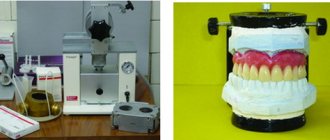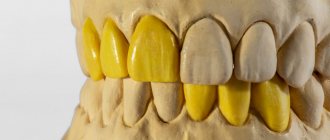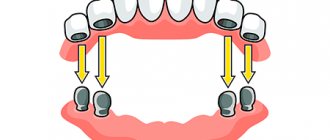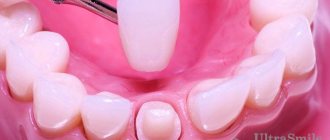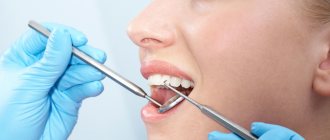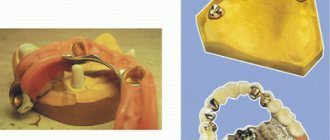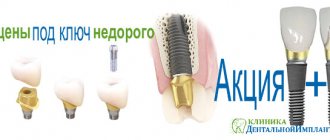The stages of making a clasp denture is a procedure that involves a professional and careful approach in dentistry. As a result of the step-by-step process, a product is obtained that successfully replaces implants and restores the dentition. The design is indicated for certain disorders and in the absence of natural units in the dentition. It is installed during the period of preparation for prosthetics to maintain aesthetics, correct deep bites, as well as for the treatment of periodontal disease and bruxism. Clasps have a number of advantages and, with proper care, last a long time. Modern orthopedic dentistry offers several types of clasps, for the manufacture of which special materials are used.
What is a clasp prosthesis and its types?
A clasp denture helps to normalize chewing function and restore attractiveness in a short period of time. It is used when part of the dentition is lost, as well as when for certain reasons it is impossible to install an implant or bridge. To understand what a clasp prosthesis looks like and how it should be used, just look at the finished product.
This is a removable structure made of artificial teeth with a base simulating gum, installed on a cast metal arch (clasp). Attaching clasp dentures is designed to fix the structure to crowns, healthy teeth or implants. The device helps to evenly distribute the chewing load throughout the jaw. Most often, fixation of clasp dentures is ensured with the help of clasps linked to the units in the installed position. The model does not have a palate characteristic of plate microprostheses. The design is compact, does not cause discomfort, and is practically invisible in the oral cavity.
Separate parts of the clasp prosthesis are included in all existing models. These include:
- Frame of a clasp prosthesis (arch). This is the base that performs the supporting function and holds together all the parts of the structure. It should follow the shape of the hard palate or alveolar area of the lower jaw;
- Fixing parts;
- The base part on which artificial teeth are placed.
To extend its service life, it is important to follow the rules of care and know how to remove a clasp prosthesis of a specific model.
Types of clasp dentures are classified depending on the material used to make artificial teeth (plastic or composite materials) and the method of fixation.
Methods for fixing clasp dentures
1. On clasps . They are considered budget designs. They are easily removed and are held on the supporting teeth with the help of flattened metal hooks - clasps. Clasps firmly hold the device in the mouth without damaging tooth enamel. Hooks are manufactured in accordance with the parameters of the supporting units. The clasp clasp prosthesis is strengthened only when it reaches the front side of the dentition and is noticeable during conversation, which is considered a disadvantage of this model.
2. On attachments (micro-locks). Fixation is carried out using micro-locks, invisible from the outside. The elements of a clasp prosthesis of this type are located as follows: one of them, the patrix, is located in the microprosthesis itself, the second, the matrix, is mounted in a metal-ceramic crown, which is put on the abutment tooth. Fixation is performed automatically when put on. There are rail, crossbar and spherical micro-locks. When asked which clasp prosthesis should be chosen and which is better, experts generally indicate the model on the attachments. It differs from the clasp type in its high aesthetic characteristics, it is compact, lightweight, and has a reliable fixation. The condition for establishing this type of device is the absence of periodontal tissue diseases and the presence of the required size of the coronal zone of the supporting part. The downside is the inevitability of grinding the supporting teeth.
3. On telescopic crowns . Fixation is done using composite crowns. The removable element is an artificial tooth with a cavity inside, and the supporting base is a stump turned to the appropriate shape, covered with metal on top. It is used in the absence of the majority of teeth, the smoothness and small size of the remaining fragments, as well as in the presence of chronic pathologies of periodontal tissues. The design is lightweight, has high aesthetic characteristics, and helps concentrate the load when chewing only on the supporting parts, thus reducing the likelihood of damage to the mucosa.
4. Splinting fastening . Splinting clasp prosthesis is used for periodontitis, the absence of a large number of teeth and the unstable condition of the remaining ones. A prerequisite for this is the presence of elements with the required height on which the structure will be attached. The arc of the clasp prosthesis of this model connects the caps (fixed part) and matrices (removable part). It is attached to healthy teeth from the inside using metal plates that accurately follow the shape of the teeth. Long-term wearing of the device does not spoil the enamel or damage the mucous membrane.
What is a clasp?
The clasp is a titanium, chromium-cobalt or gold-platinum frame in the shape of an arc with special fasteners. The main advantage of such dentures is their ability to rest not only on the gums, but also on the body of the jaw, palate, alveolar processes and healthy teeth.
Thanks to this design, the chewing load and pressure are evenly distributed over the entire dentition, preventing the process of loosening and premature loss of healthy teeth.
Nowadays, clasp prosthetics is becoming more and more in demand and popular.
This is due to a noticeable qualitative leap in the production of prosthetics. Modern clasps have a lightweight, durable, openwork design and practical fastenings that are invisible to prying eyes; they are durable, reliable and easy to use.
Stages of prosthesis manufacturing
Making clasps is a long, step-by-step process. The device is created for each patient using casts of his jaws.
The stages of prosthesis manufacturing are divided into clinical and laboratory.
The clinical stage involves
- Examination of the patient. The condition of the oral cavity and dentition is analyzed, the type of occlusion is determined, support units are selected, and a schedule for eliminating the defect, if any, is drawn up. Installation of a prosthesis is carried out only after complete recovery of detected oral diseases.
- Preparation of supporting units for prosthetics;
- Taking impressions of jaws to make diagnostic and auxiliary models. Correction and identification of deficiencies is done during a trial fitting. Deficiencies are corrected in the laboratory;
- Final placement of the structure, checking balance.
After receiving the impressions, the specialist begins manufacturing the device. The stages of manufacturing a clasp prosthesis in laboratory conditions are as follows:
- A diagnostic version of the model is created from marble plaster. The specific structure of the patient’s oral cavity must be taken into account.
- The type of bite is modeled by correctly placing the jaws relative to each other. The pressure on the units that are planned to be used as reference is measured.
- The diagram of the future design is presented on the layout. The same model simulates the process of grinding teeth-supports.
- A model of the system frame is being developed, as well as its casting.
- Artificial chewing parts are placed on wax balls, and a row of restored teeth is formed from them.
- The resulting structure is placed in a plaster mold and melted. The wax is removed and an acrylic mass is poured in its place.
- All parts are combined into one structure. Grinding and polishing is carried out. The finished product is sent to an orthopedic dentist to be fixed in the patient’s mouth.
The process of adaptation to the prosthesis occurs without discomfort. The unusual sensations after the installation of the structure pass quite quickly.
Features of the clinical stage
This stage involves several visits to the orthodontist, during which the following is performed:
- examination of the patient - based on its results, a treatment plan is drawn up;
- selection/preparation (treatment, grinding) of abutment teeth - special attention is paid to this stage in order to avoid overload and loss of healthy teeth during use;
- creating a cast of the jaw – several impressions are made for each jaw;
- production of a model of the prosthesis based on the impression obtained, experimental fitting of the finished product, making adjustments if necessary;
- final fastening of the device in the oral cavity.
Stages of clasp prosthetics
Preparation of prosthetics
Preparation for clasp prosthetics begins with an examination of the patient. Doctors carefully listen to the patient’s complaints and wishes, conduct a dental examination, and study the patient’s medical history. After this, after analyzing the results of the examination, dentists decide on the need for clasp prosthetics.
Treatment of dental diseases
Before the production of the prosthesis begins, teeth that cannot be preserved are removed, periodontal disease and other dental diseases are treated. If there is a pronounced inclination of the abutment tooth or if there are restorations on it, as well as with prosthetics using telescopic or locking fixation, crowns are put on the abutment teeth.
Caring for clasp dentures
In order for your prosthesis to serve you for a long time, you need to properly care for it. This does not require complex manipulations.
Basic advice from our dentists when wearing a partial denture:
- The denture must be cleaned with toothpaste together with healthy teeth;
- After eating you need to rinse your mouth with water;
- Once every 2 days, the plates must be placed in a disinfectant solution;
- You need to store the prosthesis in a special case, after washing and drying it;
- Do not overload the denture with too hard food;
- You need to learn to chew food with your lateral teeth on both sides.
What not to do when wearing a partial denture:
- Expose dentures to high temperature, chemical and mechanical damage;
- Use abrasive toothpaste: it leads to oxidation of the metal base of the dentures;
- Drink coloring drinks.
Why is it worth installing a clasp prosthesis?
By installing a clasp denture, you get a large number of advantages, since dentures:
- Convenient. The thin metal arc leaves most of the palate open, allowing you to taste the food.
- Do not lead to changes in speech and accidental loss of the prosthesis.
- They have high strength.
- Long service life. They can last up to 5 years, which is many times longer than the service life of conventional plastic prostheses.
- Preserves gums from deformation for a long time.
- It does not require daily removal like conventional dentures. Once every 2 days, the plates must be placed in a disinfectant solution.
- Prevents teeth from loosening.
When you can’t install a clasp prosthesis
Despite the fact that clasp dentures are often used, there are a number of contraindications to their installation:
- Diseases associated with the oral cavity and in the acute stage;
- Increased abrasion of teeth;
- Diseases associated with bone loss;
- Complete absence or low position of supporting teeth;
- Bite too deep;
- Chronic diseases of a nervous and mental nature;
- Defects in the development of the frenulum of the tongue;
- Small depth of the oral cavity;
- Individual intolerance to prosthetic materials, allergies.
Materials used in the manufacture of clasp dentures
Currently, clasp dentures are made on fire-resistant models. In the case where soldering is necessary, laser or hydrogen soldering is chosen. Thanks to this, local heating is ensured, which does not allow changes in the properties of the alloys used and is usually used to securely fasten the fixing elements.
If it is necessary to make prostheses with removal from the model or one-sided ones of short length, preference is given to special types of modeling plastic, which makes it possible to almost completely eliminate deformation of the entire structure during the work.
In full accordance with the materials from which clasp dentures are made, the cost of the finished product, indicators of strength, convenience and period of use are added up.
Today, the following materials are chosen for such structures:
1. Metal-free or quadrotti prosthesis. The arc in them is made from durable types of pressed plastic and ceramics. An ideal option for those patients who have an allergic reaction to metals.
The disadvantages are:
- fragility of the structure;
- short period of use;
- high risk of various types of damage to the prosthesis.
2. Clasps, the arc of which is made of chromium-cobalt alloys. They are distinguished by high reliability indicators due to the solid metal frame. The arch of the prosthesis with locking fixation includes metal-ceramic crowns.
3. A worthy alternative to designs with chromium-cobalt alloys can be gold-platinum alloys, the most expensive, but not causing allergic reactions. They are used to make arches and caps for metal-ceramic crowns.
As you can see, you can choose prostheses in full accordance with the wishes of the patient.
Conclusion: Indications for the use of removable clasp dentures
In persons with partial absence of teeth, along with end defects, combined and included defects are often encountered. Plate and clasp removable dentures can successfully replace end defects. Clasp dentures have a number of significant advantages over removable plate dentures:
- The base part of clasp dentures is minimal.
- The arch in the prosthesis ensures uniform distribution of the load between its sides.
- The prosthesis contains supporting clasps, which allow partial transfer of the load through the tissues of the supporting teeth.
- Compared to other complete removable dentures, clasp dentures can be slightly adjusted.
- The oral mucosa and gingival papillae are partially released.
- Reliable fixation of the prosthesis speeds up adaptation.
Types of clasps
Clasp-type structures are equipped with the following types of clasps, depending on the case:
- Supporting. Pressure distribution with such clasps is carried out on the mucous membrane and on dental supports.
- Retaining hooks. When the clasps settle, all the pressure falls on the mucous membrane
- Support-retaining clasps. Combines characteristics of both types
By shape and method of girth:
- With one or two arms, with one link, double, in the form of a ring
- Flat, tape
- Round or semicircular shape
By production:
- Molded (no elasticity)
- Bent (according to blanks)
Advantages and disadvantages of using clasp dentures
Benefits of prosthetics
The main advantages and advantages of clasp prosthetics are:
- durability, reliability and strength of prostheses;
- tenacity of fastening the clasp in the oral cavity;
- the ability to perform prosthetics even if there are only a few teeth in the dentition;
- ease of care for the prosthesis;
- the ability not to remove the clasp at night;
- no discomfort, impaired diction, or inconvenience when eating.
